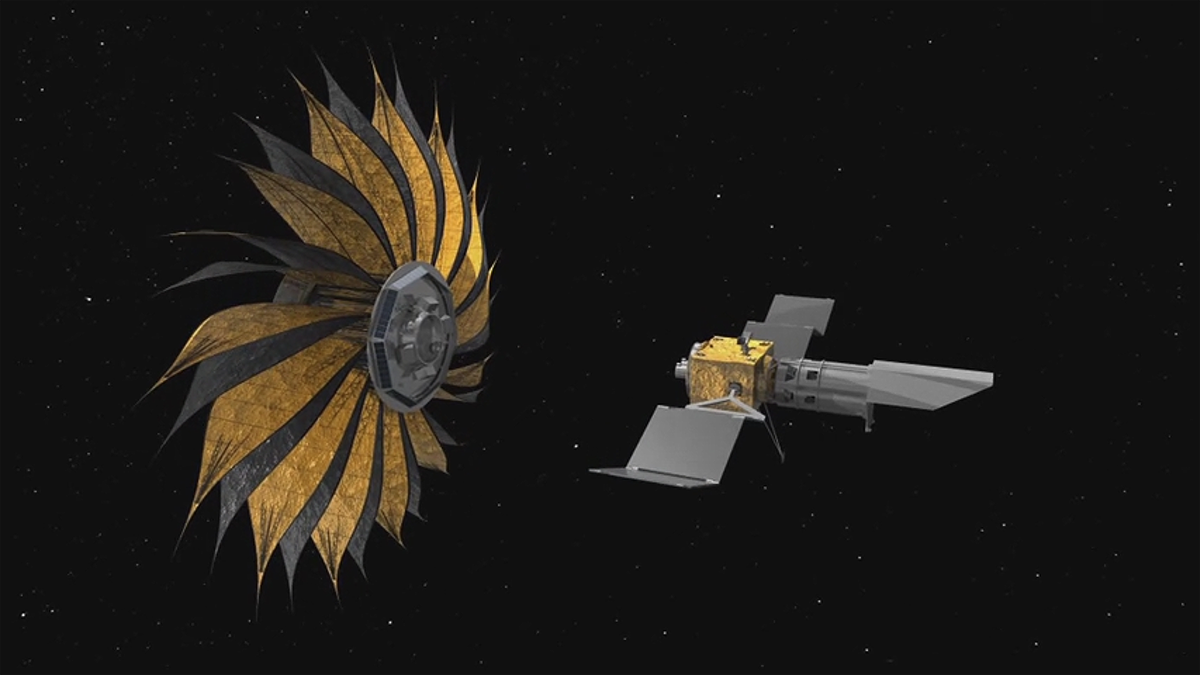
Folding NASA Experience into an Origamist’s Toolkit
Subheadline
Math for designing lasers becomes artist’s key to creating complex crease patterns
What does origami have in common with electronics? Here, math once again proves to be a universal language, spanning not just cultures but disciplines.
The discovery of the mathematical underpinnings of folded paper art helped Robert Lang leave a 20-year engineering career, including over four years at NASA’s Jet Propulsion Laboratory in Southern California, to pursue his lifelong passion for turning paper into impossibly intricate three-dimensional forms.
“Over the years of solving mathematical problems to describe lasers and optoelectronics, I built up a toolkit to use as I worked on a hobby basis on this problem of computational origami design,” said Lang. The Altadena, California-based artist holds dozens of patents for optoelectronics — technology that combines light and electricity — but after years of innovating in both fields, the tools he designed for origami are the ones he chose to move ahead with.
In the Microdevices Laboratory at JPL in the late 1980s and early ’90s, Lang worked on integrating components like semiconductor lasers and spatial light modulators onto chips, with the ultimate goal of building an optical computer — one that uses light, rather than electricity, to transmit information and carry out calculations.
Steady advances in electronic computing have since removed some of the incentives to develop optical computers.
“One of the theoretical fields I learned about at JPL turned out to be the key to being able to plug in a description of a shape you wanted and then find the best possible design in great detail — every single crease you needed to make that shape,” said Lang. “And that turned out to be nonlinear constrained optimization.”
It’s All About the Numbers
A simple nonlinear constrained optimization problem would be the challenge of packing several different-sized balls into the smallest possible box, Lang explained. The constraint is that the balls can’t overlap each other, and the solutions are nonlinear because the balls can be any distance from each other. The optimization is in making the box as small as possible.
Designing lasers and other components required a similar calculation to minimize energy consumption, the amount of semiconductor material, and other costs, said Lang. In origami, he said, optimization means creating the largest form possible out of a given sheet of paper. Design begins with mapping the points on that sheet that will become features like a head and limbs. “I found there was an equation that said the distance between any of those two points had to be greater than or equal to a mathematical function that related to where they were in the shape I was after,” Lang said. “And that was really the breakthrough, was figuring out how to mathematically describe that constraint for every possible pair of points in the crease patterns.”
The math was too complex to solve by hand but easy for a computer to resolve using known algorithms. The ability to put the problem into accurate mathematical terms “lets you tap into all of the existing mathematics and computer techniques to solve it,” Lang said.
By the mid-1990s, he had created an open-source software called TreeMaker, the first program that could be used to design complex origami figures. Many other artists soon followed with their own software. Around this time, a new emphasis on mathematical modeling led to a renaissance in origami. Paper figures previously considered impossible, such as insects, with their bulbous bodies and long, skinny appendages, suddenly proliferated. Lang became, and remains, one of the world’s leading figures at the intersection of math and paper folding.
In 2001, he left his last engineering job to become a full-time origamist.
Engineered Origami Leads back to NASA
Lang has written or coauthored around 20 books on origami and often gives talks and classes. He also designs, creates, and sells origami art. His work ranges from small paper sculptures to huge works made from metal, polymers, and other materials, which he’s cocreated with other artists. Among these are a giant piece designed by conceptual artist Glenn Kaino that will hang in Los Angeles' Airport Metro Connector station, expected to open in 2025, as well as metal origami sculptures of a 10-foot crane outside a New Mexico library and a 25-foot Pegasus at a Texas business park, both created in collaboration with sculptor Kevin Box.
His portfolio is filled with animals, plants, and the occasional human figure, as well as tessellations, polyhedrons, and other geometrical designs. In his representational art, he’s drawn to complicated, challenging subjects like insects. “Because I‘m able to design fairly complex figures using these mathematical design techniques, I’ll take on subject matter that requires a very technical approach,” Lang said.
In designing his nonrepresentational pieces, he often reverses the process, beginning with the math and then working out a subject, he said. “If you look at some of the more geometric or abstract pieces I’ve done, those were driven by solving a mathematical problem related to folding and then saying, ‘OK, now that I have a solution, how can I create a beautiful piece of artwork that illustrates that solution?’” As an example, Lang cites a tessellation he folded from a laser-scored rectangle of wood laminate after collaborating with Brigham Young University on the mathematical problem of foldable rigid quadrilateral meshes. The purpose of the collaboration was to create engineering mechanisms, but after the team won an award for its scientific paper, he set about applying the principles to his art.
The initial project was not the first time Lang had used origami to solve an engineering problem, either. As the art of folding has crept into technology in recent years, he applied his origami and engineering backgrounds to consulting with companies to design products that involve folding, such as a collapsible radio antenna. Several years ago, he consulted with Lawrence Livermore National Laboratory on its Eyeglass space telescope concept, which aims to fold a 100-meter-wide thin-film lens into a rocket fairing in such a way that it could unfold in space without any creases affecting its performance.
He said it’s his engineering background, including his NASA experience, that prompts engineers to turn to him before other origamists. Indeed, NASA too has brought him back for consulting, including work on a computer model for folding the space agency’s Starshade concept, a huge disc that, when unfurled, would block the light from a star to give a space telescope a clear view of that star’s planets.
“So the irony is that, when I was employed full-time at NASA, I was not working on origami, but after I left, I was invited back a couple of times to work on origami-related projects,” he said, noting that these relied on his ability to describe and model origami mathematically and write computer code that could generate folding patterns — skills he’d honed years earlier as a NASA employee.
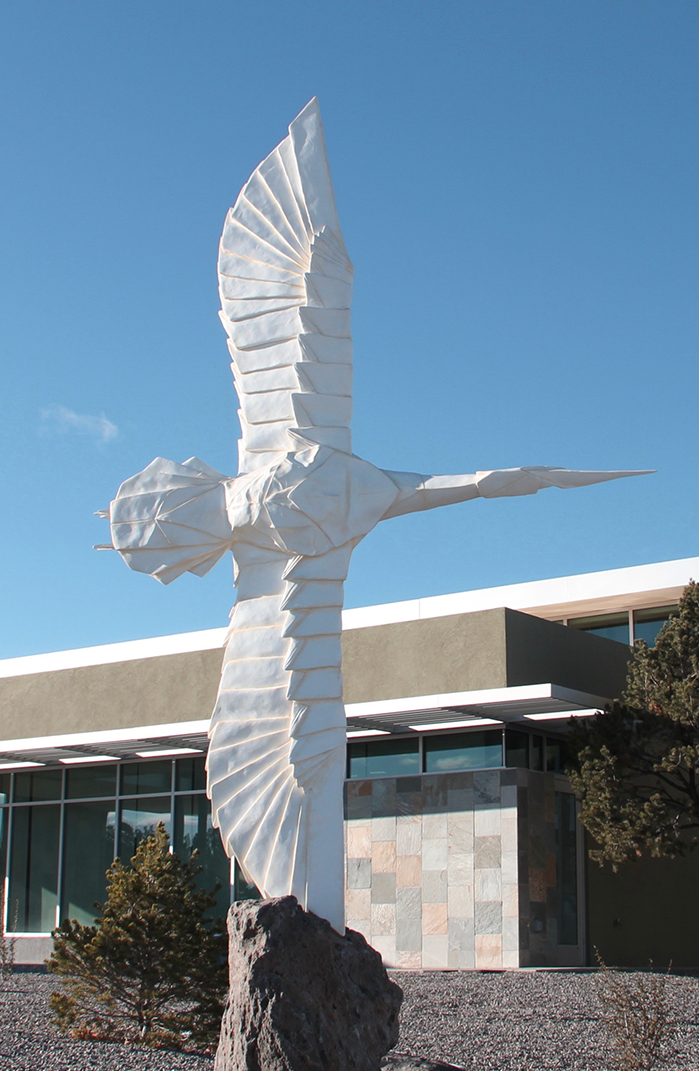
“Flying Peace,” a collaboration between origami artist Robert Lang and sculptor Kevin Box, stands outside White Rock Branch Library near Los Alamos, New Mexico. Credit: Box Studio LLC
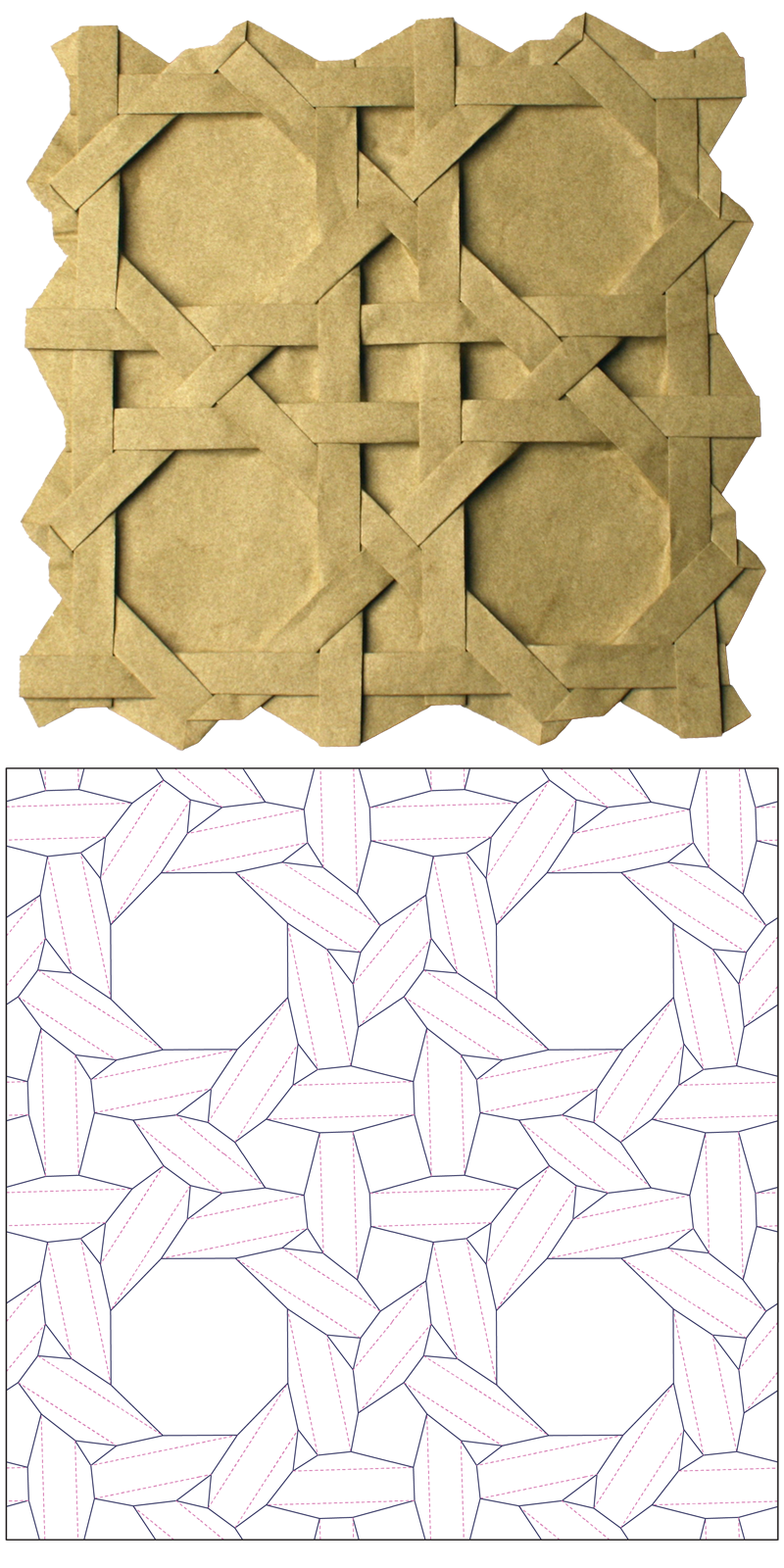
Many of Lang’s geometrical creations started as math problems related to folding, which he then worked into a design. For example, “Open Rattan Weave, Opus 663,” seen here, began when Lang discovered mathematical techniques to create folding patterns that gave the appearance of woven strips. Though the piece looks like several strips woven together over a flat backing, it’s made from a single, continuous sheet of paper folded according to the crease pattern above. Credit: Robert J. Lang
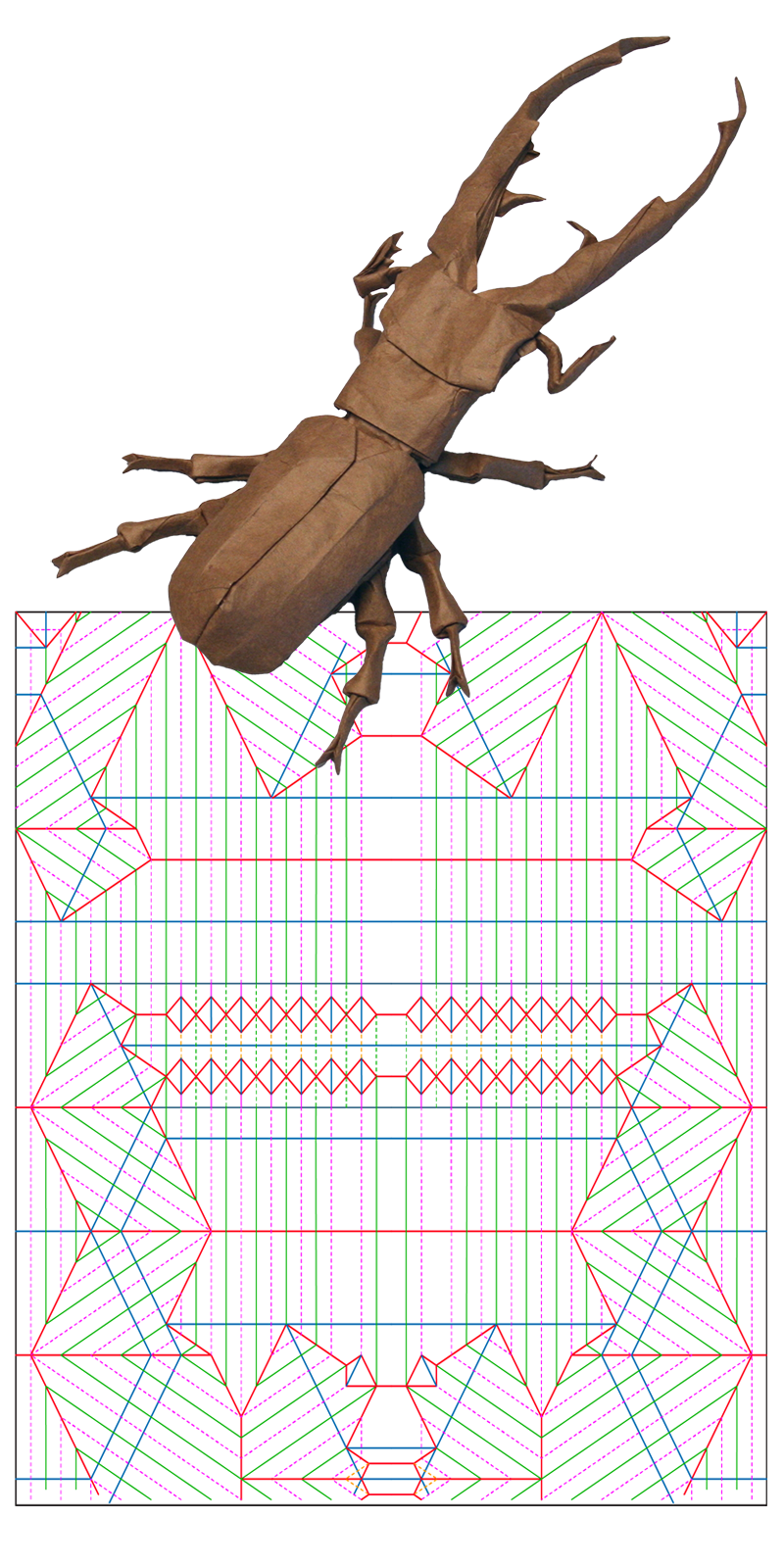
Though the art of origami is centuries old, until the late 20th century it was considered virtually impossible to make insects or other figures with many long, complex protrusions. That changed with the introduction of math-based origami design, which Lang helped pioneer. Today, he’s still drawn to the challenges presented by insects and other arthropods, and they are well-represented in the menagerie of his origami gallery. Here is a stag beetle Lang created, along with the mathematically derived folding pattern to build it. Credits: Robert J. Lang
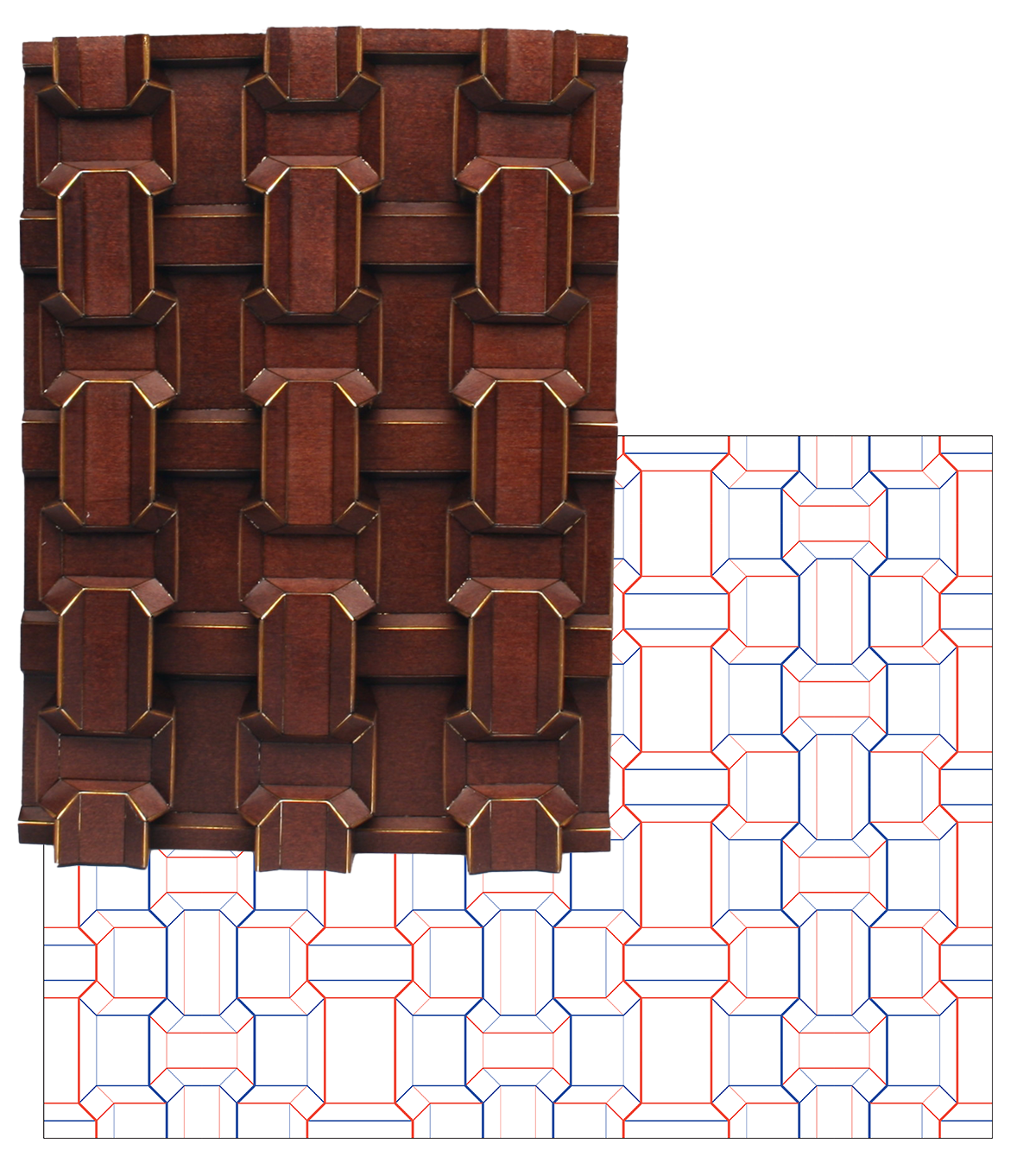
“MMMV Pillars, Opus 667” stemmed from a collaboration between Lang and Brigham Young University to design flexible figures with moving surfaces. After the team arrived at a mathematical solution and shared an award for the resulting scientific paper about “rigidly foldable quadrilateral meshes,” Lang turned the concept into this tessellation, created from a single rectangle of wood laminate, scored with a laser according to the accompanying pattern. Credit: Robert J. Lang

Since Lang left NASA, the agency has called him back in to consult on a few projects that capitalized on his dual background in engineering and origami. One of those was the Starshade concept, a design for a baseball diamond-sized disk that would fold up tightly to fit in a rocket fairing and then unfurl in space. There, it would block the light from a given star so a space telescope could photograph its planets. Credit: NASA/JPL-Caltech/Johns Hopkins APL/Ed Whitman













